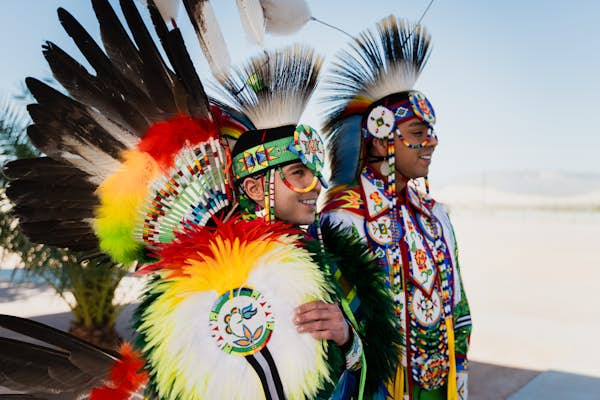Indigenous art, often full of symbolism and
meaning, is an important part of Nevada’s rich
cultural tapestry. Spanning a wide array of traditional forms from pottery to
painting, basket weaving to beadwork, these expressions tell stories that
explore themes of identity and nature, spirituality and history.
Nevada artists Adrian Stevens and Sean Snyder
are redefining what it means to make traditional Indigenous art. The pair are
celebrated for their intricate beadwork
and award-winning dance and travel the world to blaze new trails for their
community as they compete as a same-sex couple.
A shared powwow
background
Sean, who goes by they/them pronouns, is an
enrolled member of the Navajo Nation and a descendant of the Southern Ute
tribe. Adrian descends from the Northern Ute, Shoshone-Bannock, and San Carlos
Apache Tribes. Even before they met fifteen years ago, both grew up dancing,
competing, and making their own regalia in powwows – exciting intertribal
events that celebrate Indigenous culture and traditions. Some powwows have been
taking place for centuries and help keep traditional songs and dances alive.
Today, they are inseparable partners. Adrian
is a grass dancer: a style of dance that originated in the Great Plains when
dancers flattened the grass and blessed the grounds as they moved ahead of the
tribe during migration. Sean is a fancy dancer: a colorful, energetic style of
dance that originated in Oklahoma.
“Even non-Natives are welcome to come and look
at the dancing, look at the food vendors, and really take in all that it has to
offer,” Adrian says.

A spiritual expression
Powwow dancing is a spiritual experience, and
both say performing in the arena is exhilarating.
“The second that song starts and you feel that
heartbeat of the drum, it’s like your soul is awakened, and you with it.”
Adrian says. “And it translates through your movement.”
Despite specializing in different styles of
dance, Adrian and Sean began dancing as a Two-Spirit couple once they fell in
love. Two-Spirit is an umbrella term used to describe LGBTQ+ people of Native
American heritage. Growing up, they didn’t see other Two-Spirits reflected in
their communities. By dancing together, they hope to change that for the
generations that come after them.
It wasn’t always easy. The pair were thrust
into the spotlight when they were disqualified from a competition for being a
same-sex couple.
“It really hurt,” Adrian says. “I remember
traveling home and feeling a sense of emptiness.”
But instead of sinking into despair, the pair
spoke out, traveling to college campuses, appearing in a documentary, and even
serving as keynote speakers in the Human Rights
Campaign’s “Time to Thrive” summit, where they talked about fighting for
change after being disqualified from the powwow.
Their voices haven’t just been heard: their
advocacy has reshaped the culture. Today, they are welcomed by the same powwow
that once disqualified them – and return to compete regularly. They may have
set out to motivate young people, but Sean says the two hear from all age
groups, even tribal elders, that their visibility has inspired them, too.
“I feel like I am representing my tribe,”
Adrian says. “I’m representing my family. I’m also representing myself in the
best way that I can in my dancing ability and my designs.”

Designing from
heritage
Adrian and Sean dance in their own creations.
Regalia is an important aspect of powwow culture, and Adrian began sewing,
cutting, and tracing designs for his outfit at an early age. He didn’t start
beading until eight years ago, while Sean has been beading since their aunt
taught them the craft at the age of 13.
Both are quick to point out that regalia is
not a costume. Costumes are for pretending, while regalia is about
representation, Adrian says.
“This is us. This is who we are. We don’t call
it a costume. We always say your outfit, or your regalia.”
The designs are rooted in their tribal
backgrounds and incorporate recognizable elements of their heritage, like
beaded flowers as a nod to the Shoshone people, who are known for their roses.
The details are important since Adrian says there is a belief within Indigenous
communities that your ancestors will recognize your design or warpaint.


Regalia starts with a pair of moccasins, which
Adrian and Sean craft by hand from smoked buckskin hide. Unlike other artisans
who embellish the footwear with small beaded designs, the duo fully covers
their moccasins with beadwork. The method is intricate and time-consuming –
it’s easy to crack a bead if you aren’t careful – and few create moccasins this
way anymore, but Adrian and Sean stick to traditional craftsmanship.
Regalia differs depending on the style of
dance. Elements may include leggings, sheepskin furs, fully beaded belts,
capes, cuffs, harnesses, and jewelry known as roaches – made from porcupine
hair, deer hair, and feathers. Some families spend years working together to
create their regalia.

Making an impact
The couple’s handiwork isn’t limited to
regalia. Their art is also shown at prestigious venues across the country. They
recently made a splash with “Beaded Birkin 25,” a replica Birkin bag beaded in
both Charlotte-cut and 24 carat gold seed beads, freshwater pearls, vintage
brass sequins, brass hardware, ermine fur accents, and vintage American
broadcloth. It’s a stunner that took months to design and two and a half months
to create.
The two are proud to be part of the Indigenous
community creating art in Nevada, and Adrian says it’s imperative to showcase
Nevada’s many tribes along with their food, art, and craftsmanship.
“Nevada feels like home,” Adrian says. “Native
Nevada feels like that place where you can go and find a piece of everything.”
“It’s so important to Native people and our
survival that we are still seen.”
With young Natives preserving and presenting
these centuries-old traditions, these art forms will be seen and cherished for
generations.

